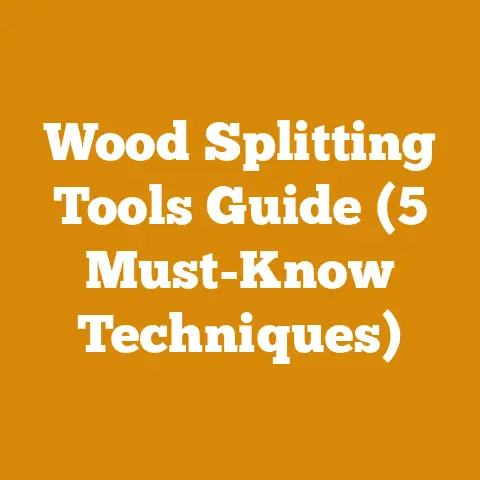Vermeer Manufacturing Stump Grinder Fixes (5 Expert Tips)
Ever notice how tree stumps seem to mock you long after the tree itself is gone? They stand there, stubborn reminders of a past life, daring you to trip over them. As someone who’s spent a good chunk of my life wrestling with wood in all its forms, from towering timber to neatly stacked firewood, I can tell you: stump grinding is a necessary evil. And when your Vermeer stump grinder throws a tantrum, it can bring your operation to a screeching halt. So, let’s dive into some hard-earned wisdom.
Vermeer Manufacturing Stump Grinder Fixes (5 Expert Tips)
I’ve spent years troubleshooting these machines, often in the middle of nowhere, with limited tools and daylight fading fast. These five tips are born from those experiences, designed to get you back to grinding as quickly and safely as possible.
1. The Case of the Mysterious Loss of Power
One of the most frustrating issues is a sudden loss of power. You’re grinding away, feeling like a lumberjack superhero, and then… nothing. The engine might still be running, but the cutting wheel is sluggish or stops altogether. This often boils down to hydraulic problems, fuel delivery issues or clutch problems.
Diagnosing Hydraulic Issues:
- Check the hydraulic fluid level: This seems obvious, but you’d be surprised how often this is the culprit. Ensure the level is within the recommended range in the reservoir. Low fluid can cause cavitation, reducing hydraulic power. I’ve seen this happen after a long day of grinding on uneven terrain, causing fluid to slosh and air to enter the system.
- Inspect hydraulic hoses and fittings: Look for leaks, kinks, or damage to the hoses. Even a small leak can reduce pressure significantly. I once spent an entire afternoon tracking down a pinhole leak in a hose, only to find it was hidden beneath a protective sleeve. Use a piece of cardboard to run alongside the hoses to check for spray. Tighten fittings and replace damaged hoses immediately.
- Test hydraulic pressure: Use a hydraulic pressure gauge to check the pressure at various points in the system, as outlined in your Vermeer manual. Compare the readings to the specified pressure. If the pressure is low, it could indicate a faulty hydraulic pump, valve, or cylinder.
Fuel Delivery Issues:
- Fuel filter: A clogged fuel filter is a common culprit. Replace the fuel filter regularly, following the manufacturer’s recommendations. I once had a grinder that would run fine for about an hour, then start losing power. It turned out the fuel filter was partially clogged, restricting fuel flow as the engine warmed up.
- Fuel lines: Check for kinks, cracks, or leaks in the fuel lines. Ensure the lines are properly connected and secured. Sometimes, old fuel lines can become brittle and crack, leading to fuel leaks and reduced engine performance.
- Fuel pump: If the engine is not getting enough fuel, the fuel pump may be faulty. Test the fuel pump pressure to ensure it is within the specified range.
Clutch Problems:
- Clutch Adjustment: Check the clutch engagement mechanism. Over time, the clutch cable or linkage can stretch or loosen, causing slippage. Adjust the clutch according to the manufacturer’s specifications. I’ve seen clutch cables snap entirely, rendering the grinder useless until a replacement was installed.
- Clutch Wear: If the clutch is worn, it may not be able to transmit enough power to the cutting wheel. Inspect the clutch friction plates for wear and replace them if necessary.
Actionable Metrics:
- Hydraulic fluid level: Check daily, maintain within the recommended range (typically indicated on the reservoir).
- Hydraulic pressure: Test monthly, compare to Vermeer specifications (found in the operator’s manual).
- Fuel filter replacement: Replace every 50 hours of operation or as recommended by Vermeer.
Takeaway: Loss of power can stem from multiple sources. A systematic approach, starting with the easiest checks (fluid levels, fuel filter) and progressing to more complex diagnostics (pressure testing, clutch inspection), will save you time and frustration.
2. Teeth Troubles: When Cutting Performance Dwindles
The teeth are the business end of your stump grinder. Dull, damaged, or missing teeth directly impact grinding efficiency and can even damage the machine itself. I’ve seen operators try to “get away” with using dull teeth, only to end up burning out the hydraulic motor or even cracking the cutting wheel.
Identifying Tooth Issues:
- Visual Inspection: Regularly inspect the teeth for wear, damage (cracks, chips), and proper seating. Look for signs of excessive wear on one side of the tooth, which could indicate misalignment.
- Cutting Performance: A noticeable decrease in cutting speed or increased vibration can indicate dull or damaged teeth. If the grinder is “bouncing” or struggling to cut, it’s a sign something is amiss.
- Tooth Rotation: Check that the teeth are rotating freely in their pockets. If a tooth is seized, it can cause uneven wear on the other teeth and put excessive strain on the cutting wheel.
Solutions:
- Tooth Sharpening: Sharpen teeth regularly using a grinding wheel or specialized tooth sharpener. Follow the manufacturer’s instructions for the correct sharpening angle and technique. I prefer using a diamond grinding wheel because it provides a cleaner, more precise edge.
- Tooth Replacement: Replace worn or damaged teeth immediately. Use only genuine Vermeer replacement teeth or high-quality aftermarket teeth that meet Vermeer specifications. Mixing different types of teeth can lead to uneven wear and reduced performance.
- Tooth Rotation/Reversal: Some stump grinder teeth are designed to be rotated or reversed to expose a fresh cutting edge. Check your tooth design and follow the manufacturer’s recommendations for rotation or reversal.
- Tooth Pocket Maintenance: Keep the tooth pockets clean and free of debris. Use a wire brush to remove rust and buildup. Ensure the teeth are properly seated and secured in their pockets.
Actionable Metrics:
- Tooth Inspection: Daily, before each use.
- Tooth Sharpening: Every 4-8 hours of grinding or as needed based on visual inspection and cutting performance.
- Tooth Replacement: As needed, based on wear and damage.
- Tooth Rotation/Reversal: As recommended by the tooth manufacturer.
Wood Type Considerations:
- Softwoods (Pine, Fir): Dull teeth more quickly due to the higher resin content. Sharpen or replace more frequently.
- Hardwoods (Oak, Maple): Can chip or damage teeth more easily due to their density. Inspect teeth carefully after grinding hardwoods.
- Root Material: Often contains rocks and debris that can severely damage teeth. Take extra care when grinding around roots.
Takeaway: Maintaining sharp, properly seated teeth is crucial for efficient and safe stump grinding. Regular inspection, sharpening, and replacement are essential.
3. The Vibrating Villain: Diagnosing and Eliminating Excessive Vibration
Excessive vibration isn’t just uncomfortable; it’s a sign that something is wrong and can lead to serious damage to your stump grinder. It can loosen bolts, crack welds, and even damage the engine or hydraulic system. I’ve seen grinders vibrate so violently that they literally shook themselves apart.
Common Causes of Vibration:
- Unbalanced Cutting Wheel: This is often the primary culprit. An unbalanced cutting wheel can be caused by missing teeth, uneven tooth wear, or debris buildup on the wheel.
- Loose Components: Check for loose bolts, nuts, and other fasteners throughout the machine. Vibration can cause these to loosen over time. Pay particular attention to the bolts that secure the engine, hydraulic pump, and cutting wheel.
- Worn Bearings: Worn bearings in the cutting wheel hub or engine can cause vibration.
- Damaged Cutting Wheel: Cracks, bends, or other damage to the cutting wheel can cause imbalance and vibration.
- Engine Problems: Engine misfires or other engine problems can cause vibration.
Troubleshooting Steps:
- Visual Inspection: Carefully inspect the cutting wheel for missing teeth, uneven wear, and debris buildup. Look for cracks, bends, or other damage to the wheel.
- Balance Check: Use a balancing stand or specialized balancing equipment to check the balance of the cutting wheel. If the wheel is out of balance, add or remove weight as needed to restore balance.
- Tighten Fasteners: Check and tighten all bolts, nuts, and other fasteners throughout the machine. Use a torque wrench to ensure proper tightening.
- Bearing Inspection: Check the bearings in the cutting wheel hub and engine for wear or damage. Replace worn bearings as needed.
- Engine Diagnostics: If the vibration seems to be coming from the engine, perform a thorough engine diagnostic to identify and correct any problems.
Case Study:
I once worked on a Vermeer stump grinder that had a severe vibration problem. After a thorough inspection, I discovered that one of the teeth had broken off and lodged itself between the cutting wheel and the housing. Removing the broken tooth and replacing it with a new one eliminated the vibration.
Actionable Metrics:
- Vibration Check: Perform a visual inspection for loose components and debris buildup before each use.
- Cutting Wheel Balance Check: Every 50 hours of operation or as needed based on vibration levels.
- Bearing Inspection: Every 100 hours of operation or as needed based on vibration levels.
- Fastener Tightening: Every 25 hours of operation.
Takeaway: Don’t ignore excessive vibration. It’s a warning sign that something is wrong and can lead to serious damage. A systematic troubleshooting approach will help you identify and correct the problem.
4. The Hydraulic Headache: Solving Leaks and System Malfunctions
Hydraulic systems are the lifeblood of a stump grinder. Leaks, pressure drops, and other malfunctions can quickly cripple your operation. I’ve seen simple leaks escalate into major hydraulic failures, resulting in costly repairs and downtime.
Common Hydraulic Problems:
- Leaks: Leaks can occur at hoses, fittings, cylinders, pumps, and valves.
- Pressure Drops: Low hydraulic pressure can reduce grinding power and performance.
- Contamination: Dirt, debris, and water can contaminate the hydraulic fluid, causing wear and damage to hydraulic components.
- Overheating: Excessive heat can damage hydraulic fluid and components.
Troubleshooting Hydraulic Problems:
- Leak Detection: Visually inspect the hydraulic system for leaks. Use a piece of cardboard to run alongside the hoses to check for spray. Pay particular attention to hose connections, cylinder seals, and pump seals.
- Pressure Testing: Use a hydraulic pressure gauge to check the pressure at various points in the system, as outlined in your Vermeer manual. Compare the readings to the specified pressure.
- Fluid Inspection: Check the hydraulic fluid level and condition. The fluid should be clean and clear. If the fluid is dirty, cloudy, or milky, it needs to be changed.
- Component Testing: Test individual hydraulic components, such as cylinders, pumps, and valves, to identify any malfunctions.
Solutions:
- Tighten Fittings: Tighten loose fittings to stop leaks.
- Replace Hoses and Seals: Replace damaged hoses and seals.
- Fluid Change: Change the hydraulic fluid regularly, following the manufacturer’s recommendations. Use only the recommended type of hydraulic fluid.
- Filter Replacement: Replace the hydraulic filter regularly.
- Component Repair or Replacement: Repair or replace faulty hydraulic components.
Preventive Maintenance:
- Regular Inspections: Regularly inspect the hydraulic system for leaks, damage, and wear.
- Fluid Level Checks: Check the hydraulic fluid level daily.
- Fluid and Filter Changes: Change the hydraulic fluid and filter regularly.
- Hose and Fitting Maintenance: Inspect hoses and fittings for wear and damage. Tighten loose fittings.
- System Cleaning: Periodically clean the hydraulic system to remove dirt and debris.
Actionable Metrics:
- Hydraulic Fluid Level: Check daily, maintain within the recommended range.
- Hydraulic Pressure: Test monthly, compare to Vermeer specifications.
- Hydraulic Fluid and Filter Change: Every 250 hours of operation or as recommended by Vermeer.
- Hose and Fitting Inspection: Monthly.
Takeaway: A well-maintained hydraulic system is essential for reliable stump grinder operation. Regular inspections, fluid and filter changes, and prompt repair of leaks and malfunctions will prevent costly downtime.
5. The Starting Stutter: Engine Troubleshooting for Reliable Starts
A stump grinder that won’t start is a major headache, especially when you’re on a tight schedule. I’ve been stranded more than once with a stubborn engine, forcing me to troubleshoot in less-than-ideal conditions.
Common Starting Problems:
- Dead Battery: The most common cause of starting problems.
- Loose or Corroded Battery Connections: Can prevent the battery from delivering sufficient power to the starter.
- Faulty Starter: A faulty starter motor can fail to engage or turn the engine over.
- Fuel Problems: Lack of fuel, contaminated fuel, or a faulty fuel pump can prevent the engine from starting.
- Spark Problems: Faulty spark plugs, ignition coil, or other ignition components can prevent the engine from firing.
- Compression Problems: Low compression can make it difficult for the engine to start.
Troubleshooting Steps:
- Battery Check: Check the battery voltage with a voltmeter. A fully charged battery should read around 12.6 volts. If the voltage is low, charge the battery or replace it if necessary.
- Connection Inspection: Inspect the battery connections for looseness or corrosion. Clean the connections with a wire brush and tighten them securely.
- Starter Test: Check the starter motor for proper operation. If the starter motor is not engaging or turning the engine over, it may be faulty and need to be replaced.
- Fuel System Check: Check the fuel level in the tank. Ensure the fuel shut-off valve is open. Check the fuel filter for clogs. Test the fuel pump pressure.
- Spark Check: Check the spark plugs for fouling or damage. Test the spark plugs for proper spark. Check the ignition coil and other ignition components for proper operation.
- Compression Test: Perform a compression test to check the engine’s compression. Low compression can indicate worn piston rings, valves, or other engine problems.
Solutions:
- Battery Charging or Replacement: Charge a dead battery or replace it if necessary.
- Connection Cleaning and Tightening: Clean and tighten loose or corroded battery connections.
- Starter Replacement: Replace a faulty starter motor.
- Fuel System Repair: Repair or replace faulty fuel system components.
- Ignition System Repair: Repair or replace faulty ignition system components.
- Engine Repair: Repair or rebuild the engine if it has low compression.
Preventive Maintenance:
- Battery Maintenance: Keep the battery clean and fully charged. Clean the battery connections regularly.
- Fuel System Maintenance: Use fresh, clean fuel. Replace the fuel filter regularly.
- Spark Plug Replacement: Replace the spark plugs regularly.
- Engine Tune-Ups: Perform regular engine tune-ups, including checking the ignition timing and valve clearance.
Actionable Metrics:
- Battery Voltage: Check monthly, maintain above 12.4 volts.
- Battery Connection Inspection: Monthly.
- Fuel Filter Replacement: Every 50 hours of operation or as recommended by Vermeer.
- Spark Plug Replacement: Every 100 hours of operation or as recommended by Vermeer.
Takeaway: A reliable starting engine is crucial for minimizing downtime. Regular maintenance and a systematic troubleshooting approach will help you keep your stump grinder starting reliably.
By following these five expert tips, you’ll be well-equipped to tackle common Vermeer stump grinder problems and keep your operation running smoothly. Remember, safety should always be your top priority. Wear appropriate personal protective equipment (PPE), including eye protection, hearing protection, and gloves, when working on your stump grinder. And always consult your Vermeer operator’s manual for specific instructions and safety guidelines. Now, get out there and conquer those stumps!






